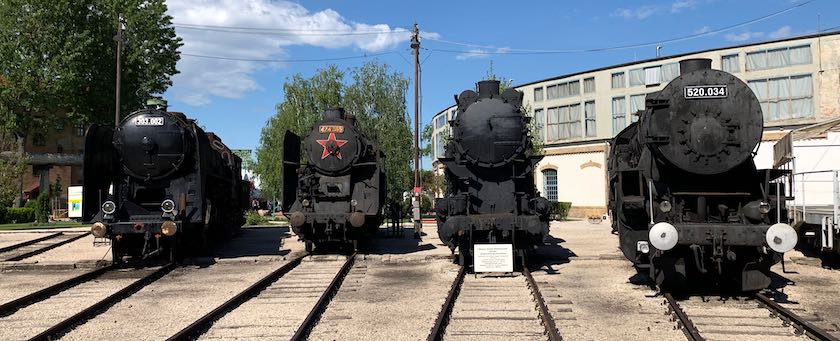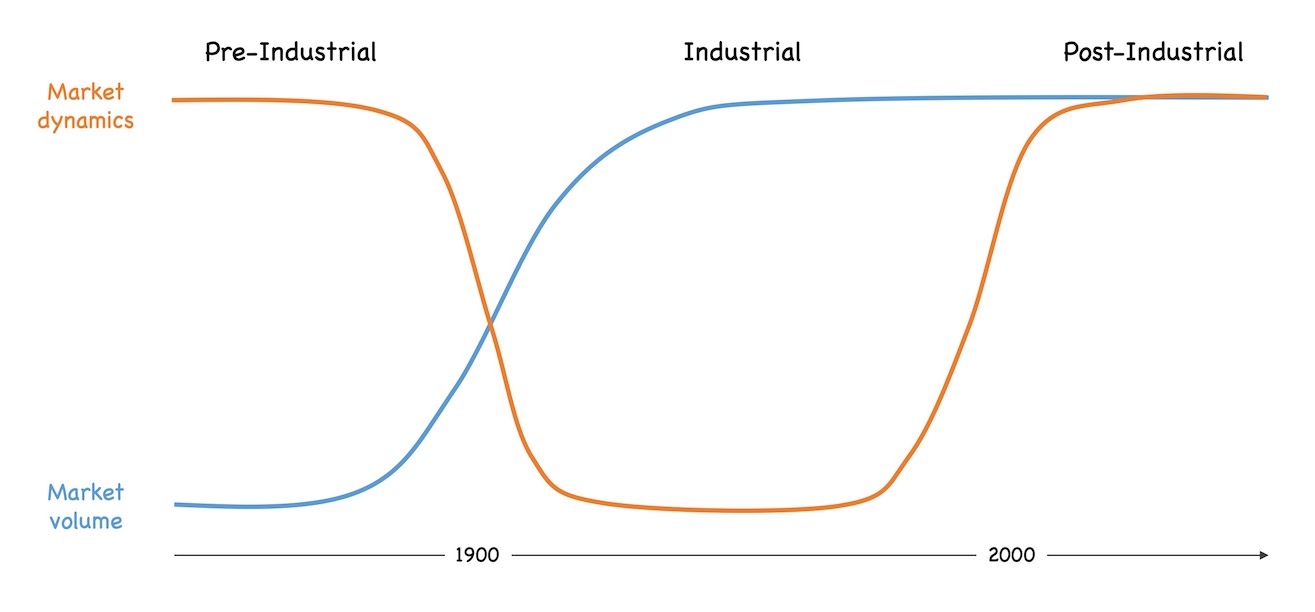The evolution of markets
A simple model to understand changing forces acting on IT

The evolution of markets
While preparing a series of blog posts describing several of the ideas I worked on in the last years, I realized that many of the topics are interrelated. Quite a lot of the ideas reference the concepts of industrial and post-industrial markets. Thus, it is probably a good idea to start with those concepts.
If you ask yourself why I talk about markets in the context of IT, please just bear with me for a moment. The core properties of the markets influence IT more than most people would ever assume and many issues of today’s IT become apparent, once you have understood those properties and how they affect IT.

Pre-industrial markets
Let us start with pre-industrial markets. Of course, IT was not yet relevant at that time (in the 19th century and before), but it lays the foundations for industrial markets. It is also useful to understand pre-industrial markets as history was repeating in IT later. But that will be a story for another post.
Pre-industrial markets were the time of craftsmen 1. If you needed a good as a consumer, you usually went to a craftsman and discussed with him what you needed. After a short consultation, the craftsman usually understood what you wanted and asked you to come back a few days later. If you did not talk at cross purposes, you then received exactly what you wanted.
From a supplier’s point of view, the key to success was mastery of your profession plus good communication skills to understand what your client wants. The Manifesto for Software Craftsmanship basically describes the same thing – just using some other words.
While this sounds very desirable, the pre-industrial production mode had two major drawbacks:
- It was very expensive. Very few people were able to afford the services of a craftsman.
- It did not scale. If you, e.g., ordered 1 chair, everything was fine. But ordering 1000 chairs was a different story. Often the craftsman was not able to carry out such an order (or simply refused to accept it).
To sum things up, a pre-industrial market is defined by the following properties:
- Local, low-volume markets
- High customization of goods
- Consumer-driven
- High dynamics (but locally delimited)
Industrial markets
We all know that the aforementioned issues of pre-industrial markets were addressed with industrial production methods. People like Frederick Winslow Taylor and Henry Ford in large part perfected the industrial production process.
They standardized the product, i.e., reduced the options to choose from. A famous quote in that context is the one that Henry Ford made 1909 in a meeting with his salesmen ‘Any customer can have a car painted any color that he wants so long as it is black’. This way of thinking laid the foundations for mass production.
Having standardized the product, it was possible to design the complete production process upfront and decompose it into small, relatively simple assembly steps. These assembly steps were connected via an assembly line. As a consequence, you did not need a crafts master anymore to build the product. Instead, it was possible to staff the assembly process with relatively untrained personnel.
This, the continuous optimization of the production process and the economies of scale made it possible to offer the product at a much lower price than it was possible with pre-industrial production methods. This had a dramatic effect: If you are able to reduce the price of a good by 50% in an unsaturated market, you reach about 10 to 50 times the number of potential customers 2.
This huge increase of potential customers in turn had another dramatic effect: Demand was a lot higher than supply. There was a vast number of people who for the first time were able to afford the respective goods. Due to this effect, sales were basically certain: if you did not screw up your product completely, people bought it. Period.
In such a setting, as a supplier your key to success is scaling your production in a cost-efficient way (without compromising the quality of your product) because demand is huge and sales are certain.
Be aware that this is the underlying assumption of all industrial production concepts that were designed in the 20th century:
In an industrial market, demand is a lot higher than supply. As a result, sales are certain.
If you take a look at the principles of most enterprises, you will find this underlying assumption in many places: their core focus is internal optimization of cost-efficient mass-production. Customers and their demands are considered predictable, i.e., sales are considered certain. I will come back to that (mis)conception in some other post.
For now, let us recapitulate: an industrial market is defined by the following properties:
- High-volume markets
- Low customization of goods
- Supplier-driven
- Low dynamics
Post-industrial markets
While industrial production was the predominant production concept of the 20th century, things eventually changed. Due to several influencing factors like, e.g., globalization and Internet business, the relation between demand and supply reversed: Supply became a lot higher than demand.
It started in the eighties of the 20th century: the relation reversed in one domain after another. For a while, more aggressive marketing and advertisement were able to increase demand artificially and thereby compensate the effects of the reversing relation. But this was not a lasting counter-measure and today basically all markets have reached a post-industrial state, i.e., supply being a lot higher than demand 3.
This has a dramatic effect, again: A customer does not buy anymore, just because a supplier offers something. There is a multitude of competitors contending for the same customers. As a result, customers will buy where their needs are met best. This creates a highly dynamic, customer-driven market. The suppliers that respond to the customers’ needs best, drive the market. Additionally, each new product or feature offered by a supplier becomes ordinary after a short time. Consequently, the needs and demands of the customers are ever-evolving.
In such a market, a sole focus on cost-efficient mass-production does not help anymore because sales have become uncertain. In a post-industrial market, it is useless to produce as much as possible as low-priced as possible unless you know that your customers are going to buy it. But here is the catch: you cannot predict reliably anymore what your customers will buy. The only way to figure it out is to actually put something on the market and see, how your customers respond. In other words: You only know if your offering is successful after you released it to the market.
In such a setting, as a supplier your key to success is continuously listen to the ever-changing needs and demands of your customers and quickly respond to them. This is a consequence of the underlying premise of post-industrial markets:
In a post-industrial market, supply is a lot higher than demand. As a result, sales are uncertain.
If you ponder the means needed to respond to ever-changing needs and demands of customers quickly, you will realize that they are quite opposite to the means for successful industrial production: Instead of rarely designing new products and then produce large batches of them as inexpensively as possible (often neglecting the customers in the process), you need to continuously test new product hypotheses, observe how your customers respond to them and quickly adapt to changing demand patterns.
Yet, many enterprises are still caught in industrial thinking which makes it hard for them to adapt to post-industrial production methods. Instead, you can see them trying to accelerate their established industrial production methods often (which of course does not have the desired effect). I will come back to that problem in a later post.
For now, let us recapitulate: a post-industrial market is defined by the following properties:
- High-volume markets
- High customization of goods
- Consumer-driven
- High dynamics
Summary
The following table aggregates the properties of the different types of markets in one place:
| Pre-industrial | Industrial | Post-industrial | |
|---|---|---|---|
| Volume | Low (local) | High | High |
| Customization | High | Low | High |
| Driver | Consumer | Supplier | Consumer |
| Dynamics | High (local) | Low | High |
Understanding pre-industrial, industrial and post-industrial markets and their success factors for suppliers is crucial for understanding a lot of the things that currently happen in IT. IT is part of the value chain of a company and thus needs to contribute to the needs of the whole company in order to successfully compete in the given market. Additionally, the means used to govern the company as a whole are usually also imposed on IT. As a consequence, it is hard (and sometimes even impossible) to understand the governing mechanics of IT without understanding the governing mechanics of the whole company which in turn are driven by the market (at least that is how it should be).
Currently, we can observe a lot of confusion in IT. We see lots of “Agile” transitions that do not feel agile at all. We see tons of new tools and approaches like, e.g., cloud native or big data (and its successors) that are used in strange ways. We see DevOps movements that completely lost track of the original ideas of DevOps. And so on.
A major driver for this confusion is that most markets transition(ed) from industrial to post-industrial which require very different, almost opposite governance models. Still, most companies – especially the bigger ones – change very slow. They suffer from an enormous change inertia. Nevertheless, they understand that they need to change. But they have a hard time adopting the required drastically different governance practices. Instead, they try to use the new tools and approaches, that promise to relieve their pain in the industrial ways they are used to – which leads to the aforementioned confusion.
I will dive a lot deeper into the model I sketched here and the effects of not understanding the needs and demands of post-industrial markets in upcoming posts. But for today, I would like to leave it here and give you some time to let the ideas sink in.
-
I use the term “craftsman” as it reflects the given situation at that time: back in the 19th century and before, women were not admitted to practice crafts business. Normally, I prefer the gender-neutral term “craftsperson”. ↩︎
-
I once had a reference for this correlation and if I remember correctly the multiplier is 50. Unfortunately, I lost the reference. If you happen to know a reference that describes this correlation, please let me know. ↩︎
-
This observation applies to most western markets. Other markets, e.g., Asian or African markets, can show different characteristics. Furthermore, this only applies to efficient markets. If a market is non-efficient, e.g., due to monopolism, lobbying or regulation, it will show different characteristics, either. ↩︎






Share this post
Twitter
Google+
Facebook
Reddit
LinkedIn
StumbleUpon
Pinterest
Email